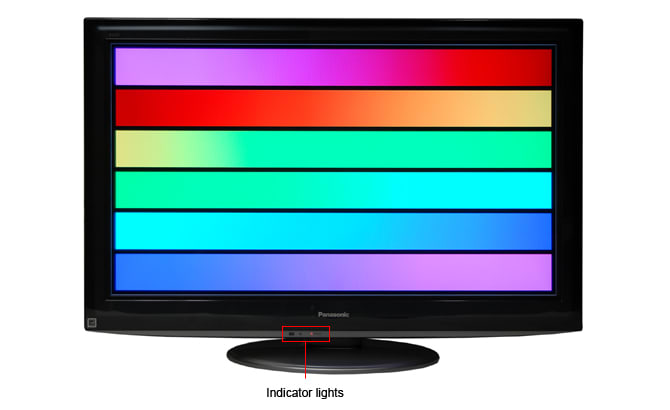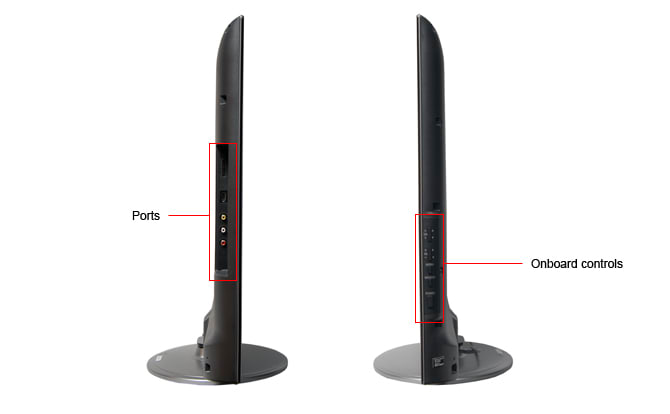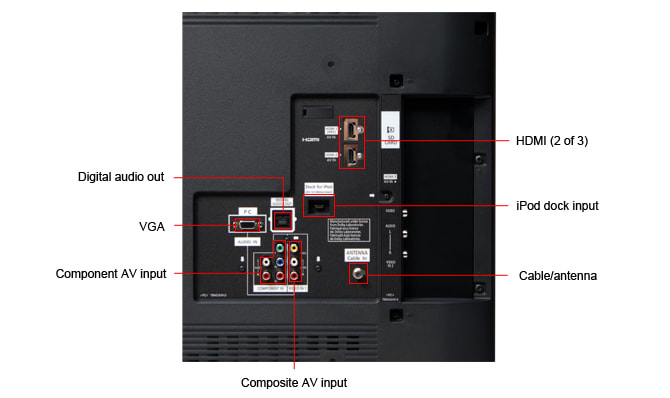Introduction
Tour & Design
The Panasonic TC-L37D2 is a simple, unadorned TV. It manages to avoid the excessively boxy look of many Panasonics. Along the bottom of the front are a series of indicator lights.

The back of the Panasonic TC-L37D2 is home to most of the ports, positioned off to one side for better accessibility. The AC power cable is hard wired into the frame, and extends from the place near the base of the TV. For information about the ports on the back of the Panasonic TC-L37D2 see our Connectivity section.

The sides of the Panasonic TC-L37D2 are not particularly thin, but then the shape is nicely rounded to give it a pleasing silhouette. One on side of the TV are the onboard controls, and on the other is a small selection of ports. For information about the ports on the sides of the Panasonic TC-L37D2 see our Connectivity section.

The Panasonic TC-L37D2 has a cheap-feeling plastic stand that screws into a sturdier, metal neck plate, which in turn screws into the back of the TV panel. Because the panel is relatively lightweight, the stand feels sturdy enough for the task. Thankfully, the stand permits the TV panel to swivel back and forth.
The Panasonic TC-L37D2 has a series of buttons running along the right-hand side to control basic functionality.

The remote control is not the best we've seen, but Panasonic isn't trying to recreate the wheel here. It's a functional, lightweight remote that does the job. For more details, jump to the Remote Control section.
The Panasonic TC-L37D2 ships with the remote control, batteries, the stand, a tri-lingual instruction manual, and some other basic documentation. There are no additional AV cables. Because the TV is relatively lightweight, one person should be able to set up the TV by themselves.
The Panasonic TC-L37D2 is a more attractive TV than some of the more expensive Panasonics we've seen this year, mainly because some care has been taken to soften the edges. The bezel has a pleasant, semi-translucent finish.
Blacks & Whites
The Panasonic TC-L37D2 produced a mediocre black level of 0.37 cd/m2. This performance is certainly far worse than the three TVs we've pulled in for comparison. If black level is crucial to you, you can always manually lower the backlight or the brightness settings. (Of course, in doing so, you'll invariable affect brightness and color performance.) (More on how we test Black Level.)
The Panasonic TC-L37D2 has no problems with producing a bright enough screen. At maximum, it produced a peak brightness of 388.3 cd/m2. That's a performance that surpassed the competing televisions, particularly the Panasonic plasma T. Unfortunately, peak brightness is not quite as important, or sought after, as a good black level. (More on how we test Peak Brightness.)
The Panasonic TC-L37D2 has a respectable contrast ratio of 1010:1. Granted, that's pretty far from the performance of the three competing televisions, and certainly not what we'd expect from a high-end television, but we've seen a lot worse. (More on how we test Contrast.)
The Panasonic TC-L37D2 showed no problems displaying consistent black levels, regardless of whether the screen is all-black, or just a little black surrounded by bright white. Typically, LCD TVs like this do fine, while plasmas can have problems. (More on how we test Tunnel Contrast.)
The Panasonic TC-L37D2 also has no problem displaying evenly bright whites, no matter how much or how little white is on the screen. (More on how we test White Falloff.)
The Panasonic TC-L37D2 does not have the best screen uniformity. We noticed, when looking at a black screen, a fairly obvious flash-lighting peeking up from the edges of the screen. Imagine how this might kill the mood of a dark, noir-ish thriller. When watching the brighter mid-tones of daytime television, however, it was hardly noticeable. (More on how we test Uniformity.)
When testing the Panasonic TC-L37D2, we noticed an egregiously poor color performance. As such, we retested under an alternate setting to try and get a better result. The results were... mixed. Our original settings put the TV in Cinema mode, which typically gives you the best color performance on any TV. On retesting, we tried Custom mode. The results are below (More on how we test Greyscale Gamma.)
Greyscale gamma measures how well a TV transitions from black to white. The chart below shows us the smoothness of the transition, illustrated by the shape of the curve. That tiny bump in the line indicates a stretch in the spectrum where the TV simply can't display the correct values. It's a minor issue. There's also the slope of the curve to consider. A slope of 2.52 is a bit steeper than is ideal (an ideal slope falling between 2.1 and 2.2).
The second chart, below, indicates the performance under the second calibrated settings from within the Custom mode. As you can see from the shape of the curve, the performance is far worse. There are two major hiccups, which you would almost surely see in the course of normal TV viewing (appearing as color banding).
Color Accuracy
The Panasonic TC-L37D2 showed only very minor problems with color temperature consistency. As the chart below indicates, the color temperature wavers as it moves through the spectrum. Only rarely, however, does it stray into the limits of human perceptibility. You'll probably never notice the errors. (More on how we test Color Temperature.)
The Panasonic TC-L37D2 scored exceptionally poorly in the RGB color curve tests. In fact, the results were so bad that we checked them again, re-evaluated our methods, and ran the tests yet again under and alternate picture mode. (More on how we test RGB Curves.)
As is the custom, we started the calibration process by putting the TV in Cinema mode. This setting (sometimes called Movie mode on other TVs) almost always allows for the most accurate color performance. It's then only a matter of adjusting a few other settings to get the best overall performance. The results of the RGB test in Cinema mode are below. What you should be seeing here is a smooth, upward-reaching curve from left to right. For whatever reason, the green channel managed it, but the blue and red channels completely fell apart.
What's unusual here is just how bad the performance is, and trying to hypothesize why it failed. There are several test screens that we, as editors, use to evaluate color performance by the eye before we run the hard tests that derive these charts. To the eye, we could tell that the blue channel and red channel were losing detail after a certain brightness (a value of around 240, for your technically-inclined readers). But the charts below indicate that the red and blue and having problems even in the mid-tones. We can only suspect that the TV must be performing some sort of heavy-handed dynamic contrast ratio or similar video processing, and that this feature cannot be turned off by a user.
After receiving the results above, we ran the tests again with the TV in Custom mode rather than Cinema mode. All we can say is 'different, but not better.' The red channel and blue channel simply can't display properly above a certain brightness.
The strips below are digital recreations, point for point, of the test results for the Panasonic TC-L37D2 and its three competitors. Note the strange color banding in the red channel compared to the idea response and the other TVs.
The Panasonic TC-L37D2 actually managed a decent color gamut, despite the disaster that is the RGB color curves. Let it be said that the color gamut test only measures four points, a red, a green, a blue, and a white point (the circles in the center of the triangle) and compares them the rec. 709 color standard. As you can see from the chart below, the color points matched up quite well, though the white point was a bit too blue. (More on how we test Color Gamut.)
The table below contains all the nerdy data of our test results.
Motion
The Panasonic TC-L37D2 was pretty good in the motion performance tests, considering how badly it did in some other testing areas. If all the video processing features were disabled, objects in motion showed some of the usual flickering and loss of fine detail, but no more so than even the best TVs fall victim to. If you engage the feature called Motion Picture Pro 4, you can regain some of that lost fine detail, but be careful. The feature, like most motion smoothing features, can make film-based content look bizarre. It's usually not worth the trade-off. (More on how we test Motion.)
The Panasonic TC-L37D2 showed few artifacts with objects in motion. There was some faint trailing in high contrast patterns, but nothing too bad. In very difficult circumstances, like high contrast, high frequency patterns (i.e. tightly grouped black & white stripes) the processing definitely choked a little. We've seen better processing, but we've also seen a lot worse. Surprisingly, though, the Motion Picture Pro 4 processing feature did very little to improve performance in this area, which lost the TV some points.
The Panasonic TC-L37D2 showed no problems displaying 24fps content, such as what you get with Blu-Ray discs. In order to get the best performance, just be sure to leave the 3:2 Pulldown setting in 'auto' mode. (More on how we test 3:2 Pulldown and 24fps.)
The Panasonic TC-L37D2 has a native resolution of 1080p (1920 x 1080), but much of the content that you'll watch on it will likely be of a lower resolution. It's up to the TV's internal processing to upscale the content to fit the screen. Overall, thePanasonic TC-L37D2 performed this task adequately. ( More on how we test Resolution Scaling.)
480p
When viewing 480p content, the TV lost 2% of the top and bottom and 2% of both sides to overscan.
720p
With 720p content, the screen lost 2% on every side to overscan. We also noticed some serious problems with high frequency patterns, wherein the TV created false coloration.
1080i
The 1080i content we reviewed had no overscan problems, but showed even more problems with high frequency patterns.
Viewing Effects
The Panasonic TC-L37D2 has a native 1080p resolution (1920 x 1080), and can play back all standard NTSC resolutions.
The Panasonic TC-L37D2 has a weak viewing angle, but is not so much worse than most LCD televisions. It loses a significant amount of contrast after 48 degrees (24 degrees from center on either side). Though it's worse than the other two LCDs in comparison here, all three pale when compared to the plasma Panasonic TC-P42U2. (More on how we test Viewing Angle.)
The Panasonic TC-L37D2 has an unusually reflective screen. When a light shines at a direct, dead-on angle, it is reflected back several times over, each in a distractingly beautiful rainbow-colored hue. If you're watching a very dark screen, it's incredibly noticeable. However, if you can managed to move either the TV or the light so that it's coming in at a less severe angle, you'll decrease the reflective effect considerably. (More on how we test Reflectance.)
The Panasonic TC-L37D2 has several video processing modes, much of which do little to improve the picture.
Calibration
[

](http://www.displaymate.com/)Because we ran into some bad testing results with the Panasonic TC-L37D2, we attempted a second run at the test under an alternate calibration. The details are below.
The Panasonic TC-L37D2 has five video modes.
Remote Control

Ergonomics & Durability*(6.25)*
The remote control that ships with the Panasonic TC-L37D2 (model number N2QAYB 000485) is standard for a many of the 2010 Panasonics. It's purely utilitarian. The remote feels boxy and angular in your hand, but it's nice and light.
The buttons on the remote control have an unusually long key travel – the distance a button travels from its rest state to being pushed all the way down. It sounds strange to say, but it feels like it takes too much work to use this remote. They also squeak sometimes.
Programming & Flexibility*(1.0)*
The remote control be used on other Panasonic AV devices, but it's not a programmable universal remote.
Connectivity
The Panasonic TC-L37D2 is certainly not bursting with ports, but it has enough for basic home entertainment systems. There are 3 HDMIs, 1 component AV input, 2 composite AVs input, and others. The big feature that Panasonic is pushing on this model is the iPod dock, which we detail below in the Media section.

As you can see from the pictures, the ports on the TV are well-labeled and easy to reach.

The Panasonic TC-L37D2 has just one output port, a digital audio out. The absence of an analog audio output means you'll have trouble connecting the TV to older sound systems. We're sure Panasonic would be happy to sell you a shiny, new 5.1 channel surround sound system.
The Panasonic TC-L37D2 does not have LAN or WiFi connectivity, nor does it offer DLNA support.
The Panasonic TC-L37D2 has an included iPod dock, which connects to the TV via a thin cable. For more details about the iPod dock, jump to the Multimedia section.
The TV also has a card slot for SD and SDHC cards. Only JPEG playback is supported though, so you won't be able to listen to music or watch video clips through the card slot.
The Panasonic TC-L37D2's ports are located on the back and side. Panasonic never tries to get clever or fancy trying to make the ports too discreet. They're easy to access and clearly labeled. The TV panel swivels on its port, so you can get to the rear ports with no problems.
Audio & Menus
The audio quality of the Panasonic TC-L37D2 is par, for a mid-range TV. As you might expect with small, built-in speakers, there's very little bass response. If you have the volume up too loud, you'll start to hear some tinny rattling.
The menu interface offers bass and treble sliders, but not a full equalizer. Of course, there's also a surround sound emulator. It seemed to push the highs and mids too far up into the mix. We preferred leaving it off.
The menu interface on the Panasonic TC-L37D2 is roughly the same menu as all the mid-level Panasonic LCDs and plasmas. The main items are listed in a vertically-aligned list. It's a clean, simple menu, and certainly not flashy. Because of the key travel issues with the remote, the actual interface with the menus is a bit sluggish.
The Panasonic TC-L37D2 comes with a three-language instruction manual that does a good job of answering all the basic questions. You can find the online version here.
Multimedia & Internet
The Panasonic TC-L37D2 does not offer any internet or streaming content features.
Photos can be viewed by using the SD/SDHC card slot. As soon as you insert a card, a menu pops up asking if you if want to view the photos. If you confirm that you do, another screen appears, offering preview thumbnails of all the photos. You can create customized slideshows and add music, either from a pre-loaded track or from your iPod.
The Panasonic TC-L37D2 can't play music or video from SD cards, but it does have the unique ability to interface with your iPod when you use the included docking station. As you can see from the screen shots below, the interface definitely lacks the elegance of a typical Apple product, but Panasonic's bullish pragmatism makes for something that's at least usable.
You can play music, videos, or podcasts, but pictures and other apps are completely invisible to the TV. Navigating through Panasonic's menu system has a small learning curve, because it's not always clear what to click on. Note that for music playback, you cannot create on-the-fly playlists (typically a standard feature on TVs). You have to rely on playlists already created in the iPod.
When you select a movie, the playback begins in a small window, like the photo below. You can click on it to expand the movie to full screen. The only real problem is the fast forward and rewind, which move at a snail's pace. If you hit the Next Chapter button, it actually skips to the next movie.
The big feature on the Panasonic TC-L37D2 is the included iPod dock. It's not a particularly innovative feature, as it's something you can buy from dozens of third party manufacturers. Panasonic is simply making the interface easier by providing the hardware and putting the menus on the TV screen. The hardware is just a plastic docking station and a short wire that plugs into the back of the TV.
Power Consumption
The Panasonic TC-L37D2 consumes a modest amount of power. By our calculations, it should only cost about $13.12 per year to operate, if the backlight is set low enough. For better picture performance, though, you may want the backlight higher.( More on how we test Power Consumption.)
As you can see from the chart below, the Panasonic TC-L37D2 is the cheapest of these four TVs to operate. The Panasonic TC-P42US, the outlier, is a plasma TV. These typically consume more power than an LCD.
Vs Panasonic TC P42U2
Value Comparison Summary
The Panasonic TC-P42U2 is an inexpensive plasma display. Panasonic certainly sells a lot more plasmas than LCDs, so it was interesting to match these TVs against each other. On the whole, neither one was great. The TC-P42U2 seemed to be equipped with a weak processor, as we saw lots of problems with upscaling lower resolution content. The Panasonic TC-L37D2 is smaller and yet more expensive. Sure, the included iPod dock is cool, but the terrible color performance and mediocre contrast ratio are probably not enough to win us over. If these two TVs are any indication, it seems like Panasonic just doesn't build low and mid-level TVs nearly as well as they do high-end sets.
Blacks & Whites
The Panasonic TC-P42US, as a plasma display, easily beat out the LCD panel of the L37D2. However, plasmas typically have a weaker peak brightness, and that was the case here, as well. Overall, the P42US has a wider contrast ratio, but we tended to like the L37D2 better overall.
Color Accuracy
The Panasonic TC-L37D2 had a big problem with its RGB color curves, which definitely puts it out the running in a match-up with nearly any television, at least in terms of color performance. However, it did manage a better color temperature consistency, which is some small consolation.
Motion
The motion performance of plasma TVs can sometimes be preferable to LCD displays, usually in terms of the image smoothness. That was the case here, as well. The TC-P42US was certainly not amazing, though.
Viewing Effects
The Panasonic TC-P42U2, as a plasma, easily trumped the LCD displays in this group. A wide viewing angle is one of plasma's great strengths.
Connectivity
Neither Panasonic TV is endowed with a huge number of ports. However, the Panasonic TC-L37D2 has the benefit of that iPod dock, which could come in handy. Notably, neither TV has an analog audio output, which may make it hard to connect to an older stereo system.
**
**
Vs Samsung LN40C630
Value Comparison Summary
It's not much of a comparison, really. The Samsung is a much better television. The performance scores were nearly all superior and it has a LAN port (with optional WiFi) to watch streaming content. Granted, it costs significantly more money, but prices drop pretty quickly when a TV has been on the market for a while. Keep an eye out and you might find a deal.
Blacks & Whites
The Samsung LN40C630 did a really great job with black levels, and LCDs never have a problem with peak brightness. As a result, the contrast ratio is great, and killed thePanasonic TC-L37D2.
Color Accuracy
The Panasonic TC-L37D2 did very poorly in the RGB color curves test, and has no hope of beating the Samsung LN40C630. However, it did manage a better color temperature consistency.
Motion
The Samsung LN40C630 showed a slightly better motion performance, mainly due to fewer artifacts than the Panasonic TC-L37D2.
Viewing Effects
The Samsung LN40C630, despite being an LCD display, showed a respectable viewing angle. The Panasonic TC-L37D2 did not.
Connectivity
The Samsung has more connection points for AV devices, and the big boon of a LAN port and optional WiFi for connecting to streaming content like Netflix. On the other side, thePanasonic TC-L37D2 has an iPod dock and fewer ports. You decide which is more important to you.
**
**
Vs Sharp LC 40LE700UN
Value Comparison Summary
The Sharp LC-40LE700 is a modest, but solid, television. If the actual selling price can be found for lower than the Panasonic TC-L37D2, isn't probably the better buy. The Sharp offers better performance and more ports than the Panasonic.
Blacks & Whites
The Sharp LC-40LE700 did not have the best contrast ratio, owing to a mediocre black level and peak brightness. The Panasonic TC-L37D2 black level may have been worse, but at least it was capable of producing a nice, bright picture.
Color Accuracy
The Panasonic TC-L37D2 showed terrible performance results in the RGB color curves, which the Sharp easily trumped. If it's any consolation to the Panasonic, at least it performed comparably in the color temperature consistency test.
Motion
The Panasonic TC-L37D2 and Sharp LC-40LE700 were roughly comparable in motion performance. Both were fine, with no major problems.
Viewing Effects
The Sharp produced a viewing angle that was very slightly wider than the Panasonic, but not enough to make a huge difference.
Connectivity
The Sharp LC-40LE700 has more ports than the Panasonic TC-L37D2, including a LAN port. Granted, Sharp has taken very little advantage of the ability to stream content through the internet, but the potential for expansion is there.
**
**
Conclusion
Series Comparison
TC-LxxD2 Series
There are two models in the D2 series, a 37-incher and a 42-incher. Both have an iPod docking station for playing music and video directly on the TV.
Meet the tester
David Kender oversees content at Reviewed as the Editor in Chief. He served as managing editor and editor in chief of Reviewed's ancestor, CamcorderInfo.com, helping to grow the company from a tiny staff to one of the most influential online review resources. In his time at Reviewed, David has helped to launch over 100 product categories and written too many articles to count.
Checking our work.
Our team is here to help you buy the best stuff and love what you own. Our writers, editors, and experts obsess over the products we cover to make sure you're confident and satisfied. Have a different opinion about something we recommend? Email us and we'll compare notes.
Shoot us an email